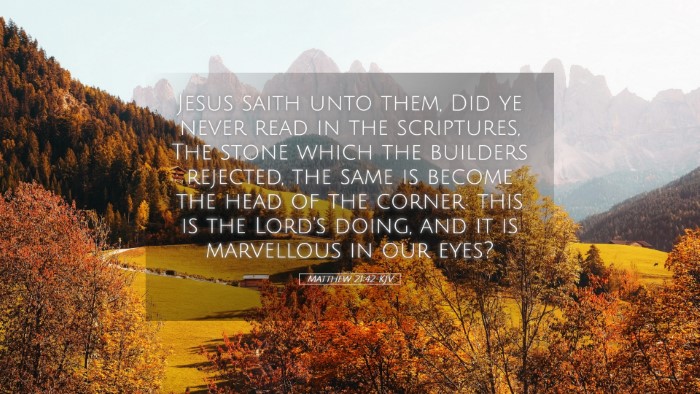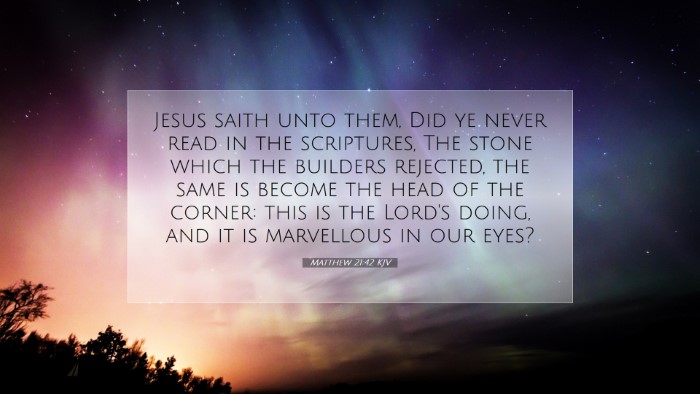Commentary on Matthew 21:42
Matthew 21:42 (KJV): "Jesus saith unto them, Did ye never read in the scriptures, The stone which the builders rejected, the same is become the head of the corner: this is the Lord's doing, and it is marvelous in our eyes?"
Introduction
This verse is a pivotal statement made by Jesus during a discourse with the chief priests and elders in the temple. It encapsulates profound theological implications concerning the identity of Christ, the nature of rejection, and God's sovereign purposes. Here, we will explore insights from notable public domain commentaries to give depth to our understanding of this verse.
The Setting and Context
In Matthew 21, Jesus had just cleansed the temple, asserting His authority over religious practices. This fierce act provoked the leaders, leading to a series of confrontations. Within this heated dialogue, Jesus cites Psalm 118:22-23, highlighting the irony of rejection faced by Him as the Messiah.
Matthew Henry's Commentary
Matthew Henry emphasizes the metaphor of the stone as representing Christ. He notes how the builders, symbolizing the Jewish leaders, rejected Jesus, yet this very stone is ordained to become the cornerstone of God's building—the Church. Henry elaborates that this rejection was not merely an oversight but a fulfillment of God's salvific plan.
Albert Barnes' Commentary
Albert Barnes provides a thorough exploration of the phrase "the builders rejected." He connects it to the historical context of the Jewish religious leaders who failed to acknowledge Christ’s divine mission. Barnes argues that this rejection demonstrates a lack of discernment and highlights the tragedy of spiritual blindness, echoing Jesus' lament over Jerusalem. He points out that the climax of this rejection results in Christ being the foundation (or headstone) of a new covenant community.
Adam Clarke's Commentary
Adam Clarke focuses on the eschatological implications of Jesus as the head of the corner. He asserts that the stone, rejected by the builders, signifies the Church's establishment on the foundational truth of Christ’s identity and redemptive work. Clarke views this as a prophetic declaration that God's kingdom would transcend the old covenant, establishing a new spiritual edifice where Christ is the sole foundation.
Theological Insights
The Rejection of Christ: The verse poignantly illustrates the nature of rejection that Jesus endured from the very leaders appointed to shepherd God's people. This speaks to the broader theme of how the righteous are often not recognized by those in authority.
Christ as the Cornerstone: This metaphor carries significant weight in the Scriptures. In ancient architecture, the cornerstone was essential for ensuring structural integrity. Therefore, identifying Christ as the cornerstone signifies His foundational role in the church and in the lives of believers. All other truths are built upon Him.
The Marvelous Work of God: The phrase “this is the Lord's doing, and it is marvelous in our eyes” invites reflection on the divine sovereignty in redemption. It underscores the notion that God is actively orchestrating events for His glory, even in the face of human rejection and opposition.
Application for the Church Today
This verse poses critical questions for contemporary believers, church leaders, and theologians:
- How do we recognize Christ amidst competing voices and authorities? Just as the builders failed to see the importance of the stone, modern believers must cultivate discernment to understand Christ’s centrality in their lives.
- In what ways do we, as the Church, risk rejecting Christ or His truth? This serves as a cautionary reminder not to allow traditions or personal preferences to overshadow the foundational truths of the gospel.
- How can we celebrate the marvelous works of God in our lives? Reflecting on the ways God has intervened in our circumstances can strengthen faith and encourage gratitude.
Conclusion
Matthew 21:42 is a profound reminder of the paradox of Christ's rejection leading to his exaltation. The insights offered from the commentaries reveal a rich tapestry of theological implications that resonate deeply in the life of the Church. As believers, we are called to embrace Christ as the cornerstone, recognizing the beauty of God’s sovereignty even amidst human failures. Thus, this verse continues to challenge and inspire devoted followers of Christ to affirm their faith in the rejected but glorified Savior.


